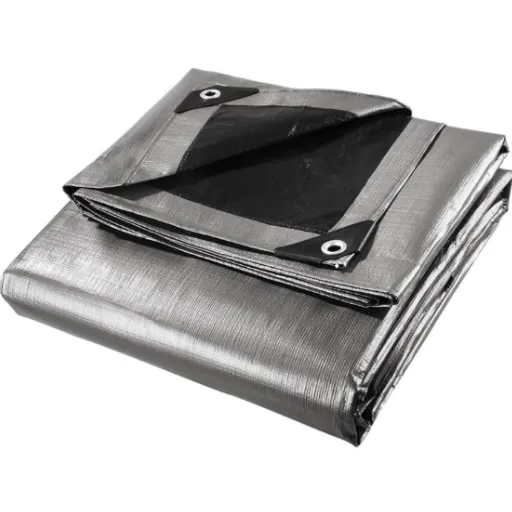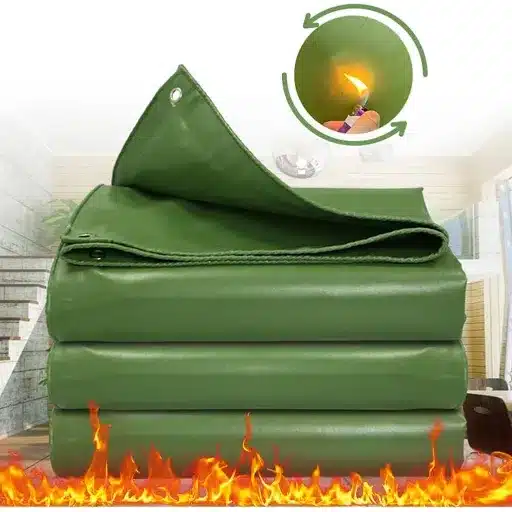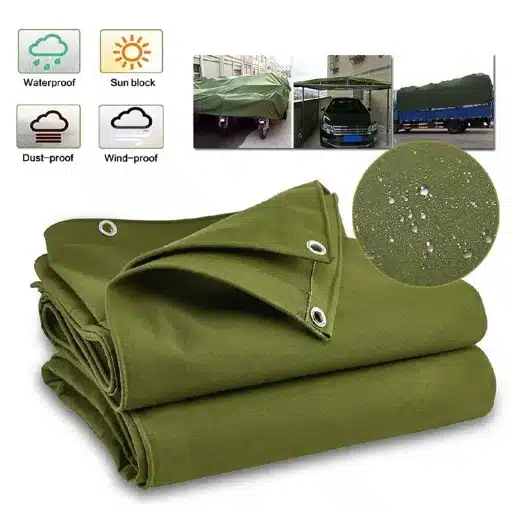A fire resistant tarp is undoubtedly the most important measure to protect your property, equipment, or outdoor areas from fires. These tarps were made to endure very high temperatures and at the same time, they also stop the flames from spreading; thus, they are very durable and safe, hence, very suitable for numerous uses. If you are going to safeguard construction materials, cover a campsite, or just make sure that safety rules are followed, fire resistant tarps will give the same level of protection that no other means can do. In this article, we will look at the main characteristics, advantages, and everyday uses that are associated with fire resistant tarps in order to arm you with all the information needed for making the right choice. Keep reading to learn the reasons why this indispensable item is a fire safety plan component.
Understanding Fire-Resistant Tarps
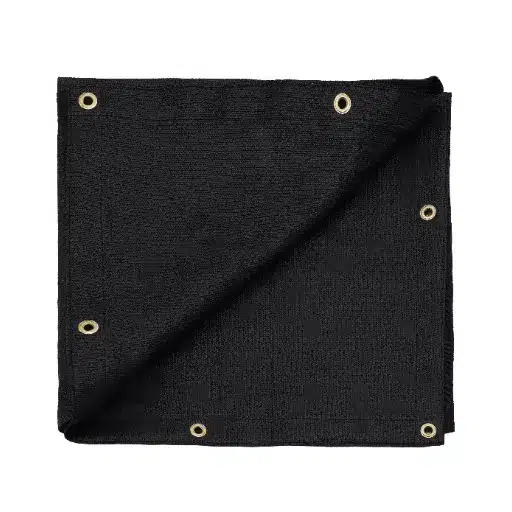
What is a Fire-Resistant Tarp?
A fire-resistant tarp is a strong covering that is capable of enduring high temperatures while preventing the flames from spreading. The materials used in making them include silicone-coated fiberglass, PVC or other flame-retardant substances, and these tarps qualify for the most demanding industry safety standards such as NFPA 701 or CPAI-84 after going through thorough testing. Their area of operation is limited to where fire susceptibilities exist, like at building sites, in manufacturing plants, or during public gatherings. Fire resistant tarps reduce the chances of fire-related losses by cutting down the heat and sparks impact, thus, safeguarding the place in several situations.
Types of Fire-Resistant Tarps
Fire-resistant tarps are not all the same; some are even more specialized than the others, and they also have their distinct applications. The most common types are presented as follows:
Polyethylene (Poly) Fire-Resistant Tarps
They belong to the group of fine and reasonably-priced tarps crafted from woven polyethylene. They contain fireproofing substances and fit very well to be used as covering during construction, temporary shelters, or when protecting outdoor equipment.
Vinyl Fire Resistant Tarps
Vinyl is the name of a material from which tarps are made that have a very high durability and are resistant to wear and tear caused by chemicals. The combination of fire-resistance quality makes these tarps apt for covering materials that are flammable, and also for being used in industrial purposes and welding workshops. NFPA 701 is one of the standards with which these tarps usually are in compliance.
Canvas Fire Resistant Tarps
These tarps are made of natural or mixed fibers coated with fire-retardant chemicals and are still air permeable and recyclable. Fire resistance is one of the features in areas such as construction, painting, and equipment coverage where air circulation is necessary along with resistance to fire.
Silicone-Coated Fiberglass Tarps
These very robust tarps are specifically created to cope with intense heat, and their use is usually associated with welding or fire containment. The silicone coating gives them durability and resistance to very high temperatures, so they can be trusted in changing industrial environments.
PVC Fire Resistant Tarps
PVC tarps have a fire-retardant coating, which also gives them excellent waterproofing along with fire resistance. So, these tarps are mainly used in large outdoor events and marine applications, and also in the places that require both flame protection along with moisture protection.
While picking a fire-resistant tarp, it is essential to think about the environment in which it will be used, the safety standards that are required, and the intended use, this will guarantee maximum protection and performance.
Key Features of Fire Retardant Tarps
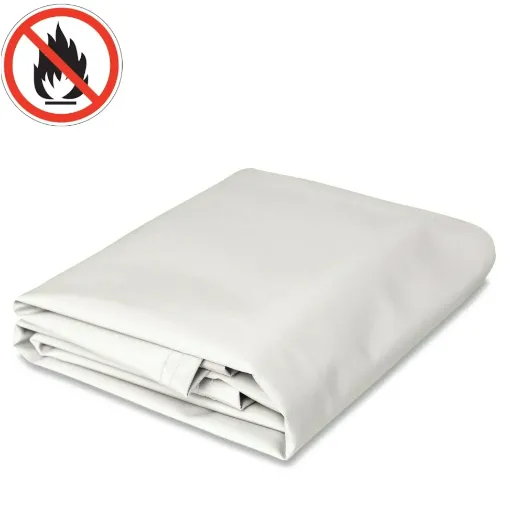
The tarp that is made fire retardant will be able to serve many purposes at one time by being safe and a durable product. The most important features of the product are listed below:
| Feature | Description |
|---|---|
| Flame Resistance | The tarps are made to have this quality by either treatment or coating with fire-retardant materials, which both lessen the flammability and finally prevent the fire from spreading. So, it is nice and safe to use them in risky places like construction sites and factories with fires in and around them. |
| Durability and Strength | Even when exposed to the most difficult environments, such as very hot or very cold weather and frequent usage, fire retardant tarps made from the most durable materials like PVC or polyethylene will still keep their fire-resistant properties intact and will not be destroyed. |
| Waterproofing | A large number of fire retardant tarps are also waterproof, which means they can be used for both fire protection and moisture resistance in places like outdoor events and marine applications. |
| UV Protection | The UV rays are harmful and many of the tarps are processed by manufacturers to resist them, thus extending the life of the material and maintaining its performance during the time it is exposed to sunlight. |
| Versatility | The variety of sizes, thicknesses, and finishes available for the fire retardant tarps makes them very flexible for different applications, such as industrial use, coverage for agriculture, or even home safety measures. |
| Compliance with Safety Standards | Fire-retardant tarps comply with the industry’s safety regulations such as NFPA 701 or CPAI-84 which provides assurance that they can be used in such environments where fire safety is of utmost importance. |
Fire retardant tarps are a combination of safe features and sturdy construction produced to meet a challenge. Weathering conditions and safety can be taken care of problematically in the same manner without adding safety risks. When making a decision about which one is right for your application, always check the tarp’s certifications and particular fire-resistant qualities.
Benefits of Using Fire Retardant Tarps
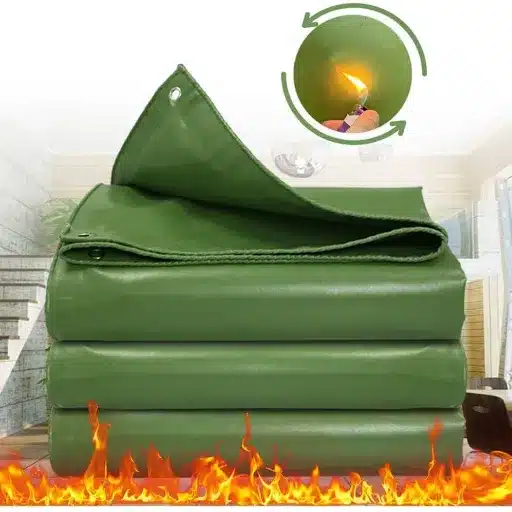
Enhanced Safety and Protection
The use of fire retardant tarps brings great safety advantages to the fore by cutting down the chances of fire in dangerous areas. The most recent sharing of knowledge indicates that these coverings are especially useful in building sites, arrangement of events, and industrial sites where the risk of fire is at its highest. They go through a process in which chemicals are used to make it hard for the flames to move, thus helping protect people and property. Moreover, the NFPA 701 or CPAI-84 certifications are the assurances that fire retardant tarps are up to the mark in passing through strict fire safety standards, thus providing tranquility in vital deployments. Fire retardant interwoven into the fabric of the tarp means that the latter is having a long life and is an effective barrier to a fire-resisting ground for facilitating.
Durability and Longevity
Fire-retardant tarps are designed to be highly effective at protecting against fire while also providing great durability and longevity. These tarps consist of premium quality heavy-duty materials like polyethylene or vinyl and are made in such a way that they could tolerate the wear and tear, exposure to the most unfavorable weather conditions, and very long usage. Generally, fire-retardant tarps that are properly maintained can last between three and five years, depending upon the environmental conditions and care taken, thus becoming a solution that is both dependable and economical for a variety of applications. Moreover, cleaning regularly and storing in a place that is neither too hot nor too cold also helps ensure these tarps have a longer life; thus, they will provide the protection and performance at their best for a long time.
Versatility in Applications
The fire retardant tarps are of such high versatility that they are able to meet the needs of different industries and areas. Building industry mainly relies on these tarps as they are able to provide protection to scaffolding, materials, and employees from using wind and rain. In addition to that, these tarps are used in manufacturing plants simply to protect the valves and the production floor from the sparks, heat, and fire that are the result of various processes and that might be hazardous. They are also a favorite cage and soil covering solution for the farm and the nursery.
Users have shown significant interest in employing fire retardant tarps for various home improvement projects like covering outdoor furniture, doing temporary repairs, and creating fire-safe zones during outdoor gatherings. Their ability to adapt to both commercial and residential settings is one of the main reasons they continue to be a preferred choice for safety and durability.
Materials Used in Fire Resistant Tarps

Poly vs. Canvas Fire Retardant Tarps
The main difference that can be noticed when it comes to poly and canvas fire retardant tarps is their respective applications and distinct properties. Poly tarps, produced from polyethylene, are noted for their long-lasting nature, lightness, and economical price. Besides, they offer relatively good water resistance and are encountered as the first choice for temporary outdoor applications owing to their mildew, corrosion, and UV (ultraviolet) rays resistance. In contrast, canvas tarps are made of a heavyweight cotton fabric thus giving them breathability and eco-friendliness as their inherent characteristics. Canvas tarps, because of their melting-point being higher than that of poly tarps, are more apt to the applications where the material used has to be strong, heat-resistant and long-lasting.
Material Comparison Summary
- Poly Tarps: Best for short-term fire-resistant needs where budget and weatherproofing are important priorities.
- Canvas Tarps: Most suitable for industrial areas or places where heat and fire resistance are critical due to long exposure periods.
Understanding Fire Retardant Coatings
Fire retardant coatings refer to the materials specially designed for application to increase the time for fire spread or completely prevent the spread. These coatings serve to act as the first line of defense against or slow down the consumption of material by fire through a fireproof barrier that reduces flammability or delays combustion when the materials are exposed to heat.
The explanation is found in the special characteristics of these coatings. For instance, intumescent coatings can be one that expands when high temperatures are reached, thereby creating an insulating char layer that shelters the material being protected. On the contrary, non-intumescent coatings change the surface chemically to the extent that it becomes fire resistant. The criteria for selecting a coating are the material being protected, its intended environment, and conformity with safety standards stipulated for the industry. The same application scenario requires both the material’s properties and the type of fire retardant coating to be compatible to get the desired performance.
Comparing PVC Flame Retardant Tarps
PVC flame retardant tarps are meant for use in areas that present a threat of fire but still offer durability and versatility of use in various applications. The major areas where these tarps are applied are construction, transportation, and industrial, as they not only resist fire but also protect the materials that are underneath.
Key Considerations When Comparing PVC Tarps:
- Fire certification standards (NFPA-701 compliance)
- Material thickness and weight
- UV light resistance
- General durability
There is a growing customer base for tarps that meet the NFPA-701 standard which signifies that the product conforms to the most stringent fire safety requirements. Furthermore, the thicker-in-material tarps provide better protection and longer life, but also, they become heavier and harder to work with. UV-resistant covering is another very important feature and for tarps used outdoors it is a must because it protects them from getting deteriorated owing to exposure to the sun for a long time.
Nevertheless, the selection of the appropriate PVC flame retardant tarp among the choices is to be made based on the specific requirements of the application, the prevailing climatic conditions, and the fire safety certifications that are compatible with the industry’s needs. The users should always look for the products that offer a perfect balance between safety and performance to be assured of an efficient and trustable use.
Applications of Fire Retardant Tarps
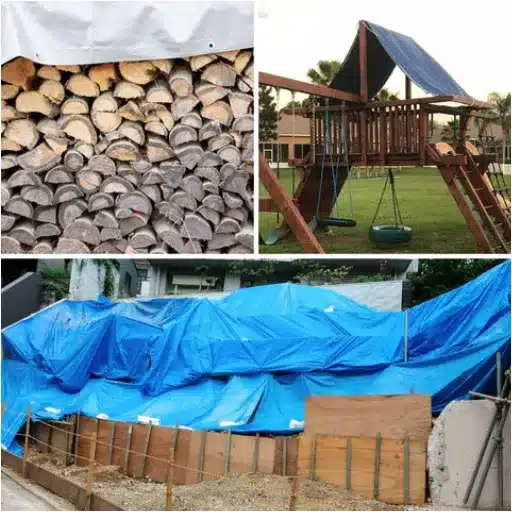
Construction and Industrial Use
Fire-resistant tarpaulins are indispensable in construction and industrial applications due to their durability and compliance with fire regulations. The main role of these tarps is to keep out the elements, rain, wind, and dirt on tools, scaffolding, and unfinished buildings. Besides, fire retardants are also used as dust-control barriers or to address chemical spills in construction projects. Fire-retardant tarps with improved UV resistance and durability in extreme temperatures are among the hottest products in the construction industry, a clear signal of ongoing demand. Rigorous compliance with safety certifications such as NFPA 701 or CPAI-84 is essential, so that fire-retardant tarps can be considered reliable for fire safety. Fire-retardant tarps offer a very safe and practical approach to creating the most secure environment in construction areas and the materials placed there.
Outdoor Events and Temporary Structures
The security and sturdiness will always be the main points while planning open-air events or the temporary construction of buildings. Fire retardant tarps are becoming more and more popular because of their ability to drastically improve safety measures. These types of tarps not only provide an efficient fire barrier but also can bear the weather conditions, thus, they can be used for events such as fairs, weddings, and trade shows. Meeting safety standards like NFPA 701 or CPAI-84 gives additional assurance to the participants and the event organizers as these standards apply the most rigorous fire safety protocols. Event planners can then easily create outdoor setups that are both secure and professional by using fire retardant tarps as their main tool of creating versatility in functionality and safety.
Emergency and Disaster Relief
Fire retardant tarps are indispensable in emergency and disaster-relief scenarios as they provide fast, adaptable solutions for the main needs. The use of these tarps in the form of temporary shelters, privacy barriers, or ground coverings is typical after storms, wildfires, or other disasters. Certainly, the non-flammable characteristics of these tarps provide an extra layer of safety especially in the disaster-hit areas where flammable materials or high temperatures may be an additional risk. Recent interest in emergency supplies and fire-resistant materials indicates that people are increasingly aware of how to prepare and stay safe during natural disasters. By using fire retardant tarps, their operations can become more efficient and secure for emergency responders’ relief efforts.
Choosing the Right Fire Retardant Tarp
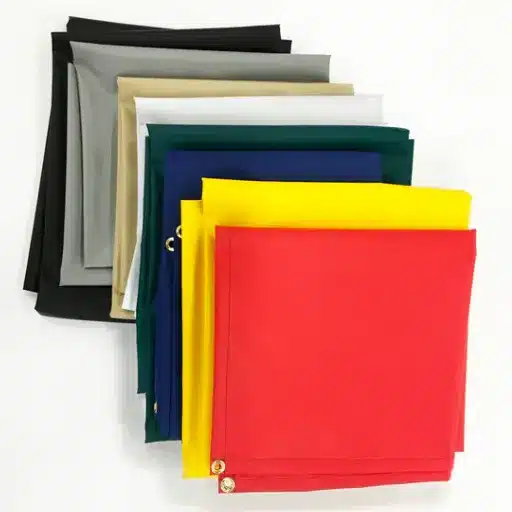
Factors to Consider
There are several critical points to think about when taking the right fire retardant tarp, which will help with the choice of the tarps that are both effective and safe.
Essential Selection Criteria:
- Material Type: Fire retardant tarps are mostly made of PVC or polyethylene, which are being treated with fire-resistant chemicals. Understanding their durability in different places is very important.
- Size and Weight: The bigger the tarps the more area covered but the harder it is to manage them during emergencies. On the other hand, the light options are easily moved but might not be as strong as the heavy ones.
- UV Protection: Some materials will not last long when the sun is very hot as it can lead to their breakdown, making UV protection a major factor.
- Certification and Compliance: The tarp’s getting the certification and the complying with the fire safety standards are very important for the reliability of the tarp in the high-risk situations.
Increased interest in fire-resistant materials is a sign that people are taking more measures to prepare for disasters. This is in line with the growing demand for tarps that not only comply with the safety regulations but also meet particular needs like portability, multi-purpose use, and durability against tough conditions. By paying attention to these factors, buyers will be able to make decisions that will not only ensure safety but also provide top-notch performance.
Recognizing Quality Certifications
When it comes to dealing with fire-retardant materials, quality certifications understanding and identifying is very important. The certifications like NFPA 701 (National Fire Protection Association) and CPAI-84 are the most widely recognized standards for flame retardant fabrics and tarps. The certifications guarantee that the materials have gone through a strict testing process to be able to meet safety and performance criteria.
Consumers are gradually leaning towards certified materials to bolster their disaster preparedness plans. This trend emphasizes the necessity of confirming product certifications in the buying process.
By doing this, the consumers will not only be sure that they are purchasing trustworthy, high-grade products that are conforming to safety standards but also getting the assurance of a hassle-free experience during the crisis.
Popular Brands and Products
Several brands have emerged as significant leaders in the disaster preparedness materials sector. When it comes to emergency supplies, consumers consistently seek out recognized, certified brands as the ones guaranteeing quality and reliability in case of emergency situations. This trend reflects a growing emphasis on safety and utility as key factors in preparedness strategies.
Frequently Asked Questions
What is a fire retardant tarp and how does it work?
A fire retardant tarp is a kind of covering that is meant to prevent the actual fire and slowing down its movement. It is made from solid fabric, most of the time it is made of heavy-duty poly, that can resist extremely high temperatures. The fire retardant effect of these tarps comes from the use of chemical agents that extinguish flames and stop them from igniting. Fire retardant tarps play an important role in fire safety of different outdoor applications, like, construction sites, camping, and emergencies. They are often rated fire resistant, which means they comply with fire safety regulations.
Are heavy duty tarps fireproof?
Heavy duty tarps are not totally fireproof but, at the same time, they are not fire resistant either. However, many heavy duty tarps get the treatment with fire retardant materials that make them more flame resistant. A fire retardant heavy duty tarp is a great choice for outdoor use as it gives protection against the natural elements as well as flame resistance. Tarps that are self-extinguishing and have safety certifications should be sought. For maximum safety, the tarp cover that mixes heavy duty materials with fire retardant properties should be used.
How do I choose the right fire resistant tarp for my needs?
Choosing the right fire resistant tarp is a matter of various factors such as the material, size, and purpose. Heavy duty poly tarps are in demand due to their long life and high resistance to deterioration. For additional durability, seek tarps with reinforced edges and rustproof aluminum grommets. If you want a tarp for construction or outdoor events, then perhaps a fire retardant poly tarp that complies with safety standards is the best choice. Furthermore, be certain that the tarp is suitable for the intended use, whether it is for shielding equipment or creating a sanctuary during emergencies.
What are the benefits of using fire retardant heavy duty tarps?
The use of fire retardant heavy duty tarps can make a huge difference, as they can make the area fire safe and also offer many other benefits. Such tarps are made to high standards and thus are less likely to catch fire at all. Minimum damage due to fire will be the result of thus causing less worry. Besides that, they can endure even the most extreme weather conditions so they can serve inside or outside. Features like reinforced edges and corrosion-resistant aluminum grommets add to the longevity and performance of these tarps. The use of fire retardant tarps is also a way to comply with fire safety regulations, especially in construction and industrial areas.
Can fire retardant tarps be used for outdoor purposes?
Absolutely! Fire retardant tarps are great if you make outdoor applications as they bring essential protection against both the fire and the elements. The thick rugged construction is what makes them able to resist harsh wind, heavy rain, and strong sunlight, thus making them versatile for such various activities as camping, car covering, and equipment protecting. Furthermore, several fire retardant tarps consist of the waterproof materials that keep their effect even in wet conditions. When these tarps are used outside, it is very important to choose the certified ones that meet the safety standards.
How do I maintain my fire resistant tarp?
Keeping your fire-resistant tarp in good condition is essential if you want to prolong its life and effectiveness. Regularly check the tarp, paying particular attention to grommets and reinforced edges, for any signs of wear, tears, or damage. To prevent mold growth, clean the tarp with mild soap and water to eliminate dirt and debris, and dry it completely before storing it. Do not allow the tarp to come into contact with harsh chemicals which would break down its fire retardant properties. Keeping the tarp stored in a cool, dry place will help to retain its integrity and flame resistance even longer.
Maintenance Tips for Fire Resistant Tarps
Best Practices for Longevity
- Conduct regular inspections focusing on grommets, reinforced edges, and seams
- Clean with mild soap and water to remove dirt, debris, and potential contaminants
- Ensure complete drying before storage to prevent mold and mildew growth
- Avoid contact with harsh chemicals that may compromise fire retardant properties
- Store in a cool, dry location away from direct sunlight when not in use
- Handle with care during installation to prevent tears and punctures
Reference Sources
- Discovering the Best Truck Tarpaulin Options
This guide discusses PVC-coated tarpaulins with flame-retardant properties, meeting international fire safety standards. Read more here - Vinyl Tarps, Heavy Duty – 18 oz
This source provides details about fire-resistant grommets and specifications for heavy-duty tarps. Read more here - Fire Prevention Plan
This document mentions the use of fire-resistant canvas tarps in agricultural and structural fire prevention strategies. Read more here
Final Thoughts
Fire resistant tarps represent a critical investment in safety and protection across numerous applications. From construction sites to emergency disaster relief, these specialized coverings provide an essential barrier against fire hazards while offering durability, versatility, and compliance with stringent safety standards. By understanding the different types of materials, recognizing quality certifications, and selecting the appropriate tarp for your specific needs, you can ensure maximum protection for people, property, and equipment. Whether you’re a professional in the construction industry, an event planner, or a homeowner looking to enhance safety measures, fire retardant tarps deliver peace of mind and reliable performance when it matters most.

